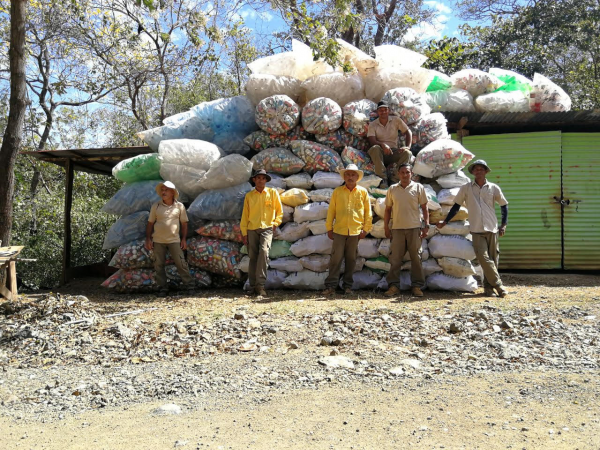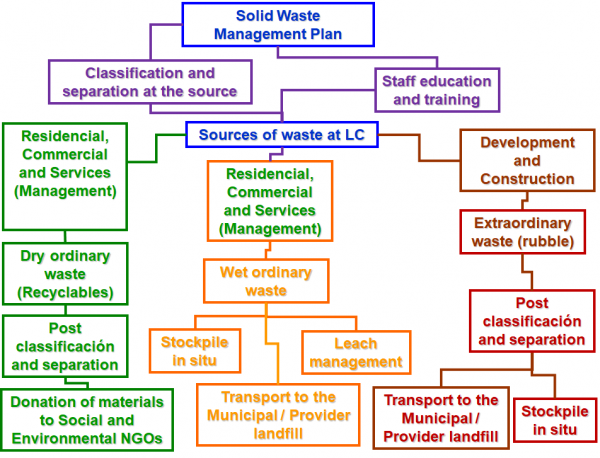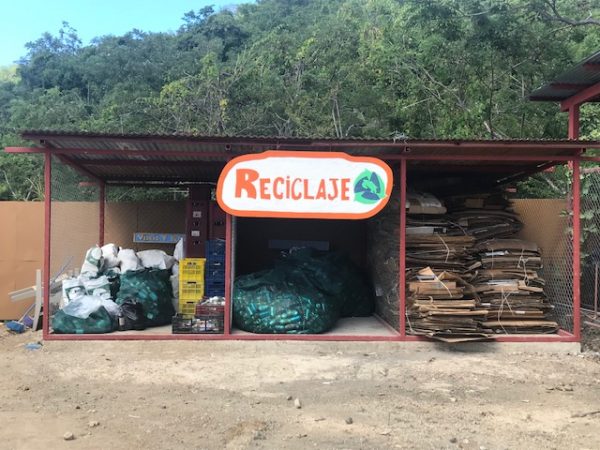Saturday, January 11th, 2020.
In this Daily: Recycling and Waste Management in a Sustainable Town
There are many pieces that go into creating a town that is truly sustainable. Renewable energy ensures that the daily life of the town can thrive without drawing from expendable natural resources. Sustainable transport in its many forms helps ensure that people can move cleanly, efficiently, and effectively with clean or zero emissions.
Protection of nature ensures that the surrounding ecosystems and wildlife are protected and healthy. Thoughtful, people-centered urban designs foster a sense of community and the wellbeing of individuals within a town.
Another key element of the environmental sustainability of a small town is how it manages waste and recycling, which Las Catalinas does well enough to be considered among the leaders in recycling and waste management in the cantón of Santa Cruz.
 Part of the waste management team at Las Catalinas
Part of the waste management team at Las Catalinas
The Waste Management Ecosystem
There are two main sources of waste in Las Catalinas, construction waste and residential/service (which is further divided into dry waste and wet waste). In the course of operation, both residential/services and construction operations produce things like trash, food scraps, rubble, and other forms of waste, of which some are recyclable and others are not.
Once either of these operations produces waste, the first phase of waste management falls to each respective team. Whether a part of construction, House Moms, residential housekeeping, concierge, maintenance, or any other team, the people “on the ground” are responsible for identifying this waste and moving it to the proper receptacles like trash bins and dumpsters.
From these designated receptacles, the waste is then collected by members of the waste management team, who then oversee sorting all of this trash into the proper categories.
Waste is first divided into three categories: dry waste (papers, plastics, metals, electronics, etc.), wet waste (primarily organic wastes like food scraps, beverages, hygiene products, cleaning products), and construction waste (wood, rubble, building materials). Then, within each of these categories, items are classified into trash (to be disposed by the municipality), reusable waste (like compost for gardens or materials that can be reused onsite) and recyclables (which are delivered to social and environmental NGOs to be recycled).
 An overview of the current waste management plan at Las Catalinas. Trash and waste are typically grouped into one of three categories, which are each managed in their own way.
An overview of the current waste management plan at Las Catalinas. Trash and waste are typically grouped into one of three categories, which are each managed in their own way.
A Protocol Changing for the Better
A general overview of the process can be seen above. Waste is generated at Las Catalinas, then split out into dry waste, wet waste, and construction waste (also called extraordinary waste or rubble), where it is then either stockpiled in situ (on site) for reuse, or transported to the proper authority.
One feature to note on the above chart is the presence of both an initial classification phase as well as a secondary classification phase. This is a sign of the improvements currently happening in the waste management program.
In the early years, all waste was collected and delivered to the municipality, where the Las Catalinas waste management team then sorted through the waste to collect recyclable or reusable materials. It was an arduous, manual process, and this diligence and effort were a major contributor to Las Catalinas being named the top recycler in the cantón.
The next phase for the waste management protocol began implementation in the last year, with the expansion of the onsite waste management center. With this new center, waste can be classified before it is taken to the municipality, which saves the time and resources required for post-transport sorting. This addition, along with trainings of residential, construction, and service providers to classify trash at the source, can increase reuse and recycling by up to 60-80%.
 One section of the new onsite waste management center, part of the key infrastructure to provide sorting before trash is collected and sent to the municipality
One section of the new onsite waste management center, part of the key infrastructure to provide sorting before trash is collected and sent to the municipality
As ground teams adjust their processes and adopt this new sorting process, the waste management team has continued their sorting at the municipality (hence the second step of classification in the chart above). However, as the pre-sorting process becomes more familiar, the waste management team will be able to transition to rely on fully Las Catalinas-based sorting for all forms of waste, which will ensure that as much as possible is reused and recycled.
How To Help
As town becomes more effective at reusing and recycling waste, one of the best ways to help is to reduce the amount of waste produced. Using reusable bags at grocery stores, choosing reusable containers at home, and avoiding items with excessive packaging are all small ways to start, and can make a difference in the long run. Other decisions, like choosing recyclable or biodegradable products, only add to the positive environmental impact of this more conscious consumption and sustainable living.
These efforts, along with town efforts like new forms of transport, the continued restoration of the 1000 acre tropical dry forest reserve around town, and conscious methods of sustainable development, all help make Las Catalinas an even more sustainable community to be a part of.
[maxbutton id="1" url="https://cta-redirect.hubspot.com/cta/redirect/4917861/bb90976c-fd33-457a-a285-892e384bad66" text="Visit Las Catalinas" ]